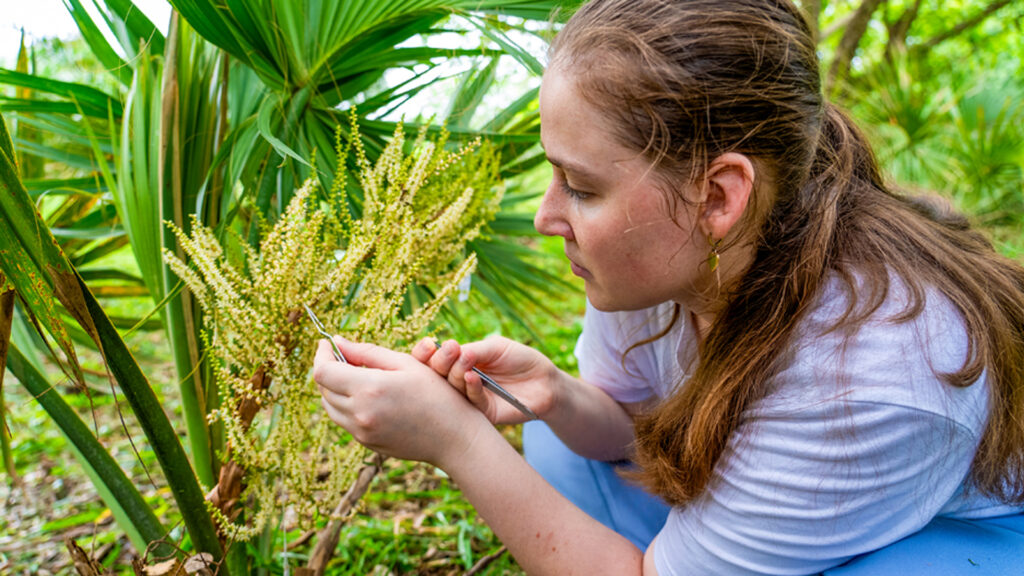By Janette Neuwahl Tannen, University of Miami News
Under the shade of tropical trees, Isabella Childress perches herself in the dirt next to one of two rare palm plants.
With a pair of very precise, sharp tweezers, she plucks a tiny white flower from the center of the palm and removes a miniscule yellow anther from it, which holds some of the sticky pollen she is trying to collect. She uses another set of tweezers to transfer the pollen into a beaker and repeats the process until she has at least 60 samples.
It is a ritual Childress has followed each morning this summer at the Montgomery Botanical Center in southern Coral Gables, unless rain interferes. And the process must happen during a specific time window when the flowers are open, and their pollen is accessible. Then Childress shuttles the pollen to a lab, where it is stained for preservation and observation.
The meticulous nature of the research is labor intensive, but Childress, a senior studying biology at the University of Miami College of Arts and Sciences, is captivated by the Sabal miamiensis, or the Miami palmetto. Native to South Florida, the species has all but disappeared from the landscape today.
“When the species was discovered 40 years ago, it was already very rare and endangered. We rescued a few palms from the path of development back then, and we were thrilled when it was rediscovered last year in northern Miami-Dade County,” said Patrick Griffith, director of Montgomery, where Childress is doing a Jennings Internship this summer. “For us, it was super exciting to find a species that was thought to be gone.”
As far as botanists know, Griffith said there are very few of these plants in the wild, and very few at gardens such as Montgomery.
Childress understands why. Since every flower possesses male and female parts, they must be pollinated by insects, and if there are just a few of the plants left, it’s hard to guarantee the insects will distribute the pollen effectively.
“Trying to get pollen from these flowers is very difficult, and it’s sticky, so that the pollen can adhere to the pollinating insects’ bodies,” Childress said, pausing to marvel at a bee buzzing through the palm’s flowers with pollen bulging from its legs.
Eventually, Childress hopes she can help scientists and conservationists grow more of these native palm trees by working to fully understand and explain its reproductive process.
“I am trying to establish a methodology for successful pollen extraction, which is really important for the conservation of ‘exceptional species,’ or those that cannot be preserved in traditional ways,” Childress said. “It is very difficult work, but it is also very rewarding.”
There are a host of challenges to save the endemic palm species. They are struggling to multiply with the impacts of climate change altering temperature, habitats, insects and other factors that influence reproduction. Wild palms may also be few and far between because their prime habitat, pine rockland ecosystems, have shrunk with rapid development.
So Childress’ research may prove useful to other palm species, too. But for now, she is focusing on the Sabal miamiensis.
To do this, she collects and stains the pollen so it can be viewed under a microscope daily this summer as part of her internship at Montgomery Botanical Center. The lush 120-acre property is now a rare palm and cycad sanctuary focused on research, but until 1990, it was also the home of Colonel Robert Montgomery and his wife, Nell, who helped to found Fairchild Tropical Botanic Garden just down the road.

Childress was first exposed to the oasis of tropical plants at Montgomery when she took a tour of the property last year with biology professor Ken Feeley’s lab, where she worked as a research assistant. In addition to his role as the Smathers Chair of Tropical Tree Biology at the University, Feeley also serves as director of the John C. Gifford Arboretum and occasionally gets palms from Montgomery to add to the on-campus palmetum. When he received a note about the internship, Feeley suggested Childress apply.
Now, Childress is incredibly glad she did.
“It’s amazing to constantly have people to learn from and listen to who are experts in their field,” she said.
But that doesn’t make her task easier. Almost each step of the research process needs revising, and some of it is trial and error just because palm pollen preservation is so rarely studied, Childress said. To effectively collect the pollen, Childress spends time reading published research articles for strategies on how to preserve the pollen so it is viable for lab fertilization. She also brainstorms with other palm botanists at the property, like Griffith, Daniel Tucker, who manages the center’s seed bank and is also studying Sabal miamiensis, and Joanna Tucker Lima, the living collections manager at Montgomery. They are eager to see Childress find answers.
“She is basically generating new knowledge that nobody has about a species that was presumed extinct, forgotten, and then was recently discovered,” Tucker Lima said. “We just don’t know very much about it, so we need to understand its reproductive biology to aid the species to reproduce and repopulate.”
Griffith is also intrigued with Childress’ work. He recently encouraged her to continue her research through the academic year, and she is thrilled by the opportunity.
“I hope to be helpful to current scientists — not to replicate something that’s been done before,” she said. “And I am fortunate to be learning new things everyday about the floral development of palms and the applications of it for conservation purposes.”
This piece was originally published at https://news.miami.edu/stories/2024/07/uncovering-new-insights-about-native-palms.html.
Sign up for The Invading Sea newsletter by visiting here. If you are interested in submitting an opinion piece to The Invading Sea, email Editor Nathan Crabbe at ncrabbe@fau.edu.



